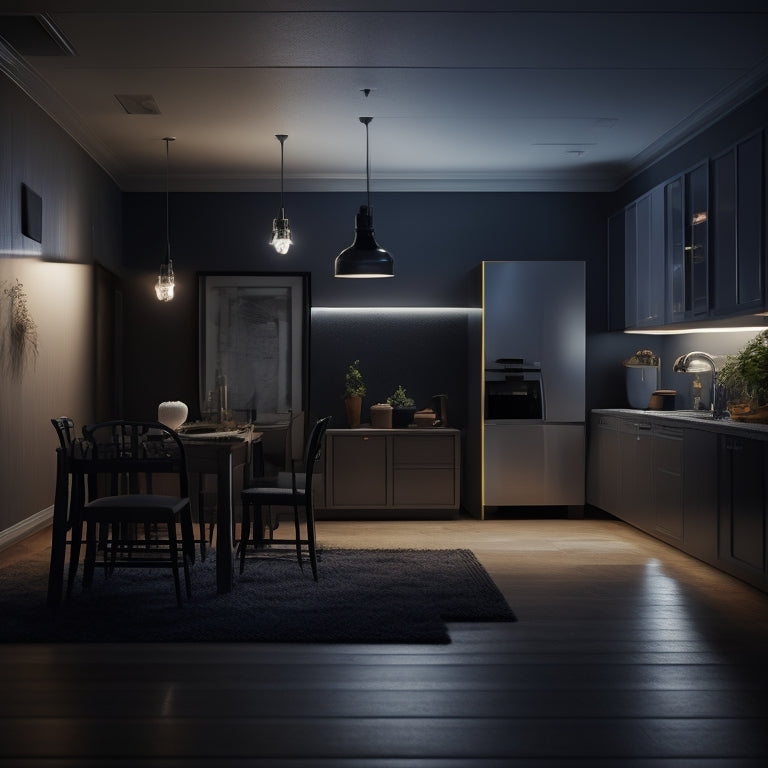
Power Through Blackouts: DIY Home Battery System Guide
Share
You're about to take control of your home's energy destiny by designing and building a DIY battery system that keeps your lights on and your devices powered during blackouts. To get started, you'll need to choose the right battery type, considering factors like energy density, lifespan, and maintenance requirements. Next, accurately size your system to meet your specific energy needs, factoring in load calculation, efficiency, and safety considerations. From there, you'll build your battery bank, install a charge controller, and connect to your home grid, ensuring a safe and efficient system that detects outages and prevents backfeeding – now, take the next step to access a reliable and efficient DIY home battery system.
Key Takeaways
- Choose the right battery type, considering lithium-ion's higher energy density and longer lifespan over lead acid's drawbacks.
- Accurately size your home battery system by calculating load, considering backup duration, and accounting for system efficiency.
- Build a compatible battery bank by selecting same-spec batteries, following manufacturer instructions, and prioritizing safety precautions.
- Install a suitable charge controller, selecting the right type (MPPT, PWM, or shunt) and ensuring proper sizing of solar panels.
- Connect to your home grid using a grid-tie inverter, prioritizing battery safety, and considering local regulations and site assessments.
Choosing the Right Battery Type
Get started on selecting the perfect battery for your DIY home battery system by diving into the world of battery types.
You'll likely come across two main options: lithium-ion and lead acid. Lithium-ion batteries boast several advantages, including higher energy density, longer lifespans (up to 15 years), and lower maintenance requirements.
In contrast, lead acid batteries are heavier, less efficient, and have shorter lifespans (around 5-7 years). When considering energy storage systems, it's crucial to evaluate the depth of discharge and cycle life of batteries to guarantee peak performance.
While lead acid batteries are cheaper upfront, their drawbacks make lithium-ion batteries a better long-term investment.
Consider safety precautions, such as proper ventilation and installation, to guarantee a secure system. Additionally, lithium-ion batteries have a lower environmental impact due to their recyclable materials.
Sizing Your Home Battery System
Your DIY home battery system's performance hinges on its ability to meet your specific energy needs, making accurate sizing a critical step in the process.
To get it right, you'll need to calculate your energy needs through a load calculation, considering factors like backup duration and system efficiency. This will help you determine the required battery capacity.
Additionally, incorporating renewable energy sources, such as solar-powered fast charging, can further enhance your system's efficiency. By leveraging these sustainable options, you can reduce your reliance on traditional energy sources.
- Consider the total wattage of your essential appliances and devices
- Account for safety considerations, such as overcharge protection and surge capacity
- Plan for routine maintenance tips, like monitoring system performance and updating installation tools
Building the Battery Bank
As you move forward with building your DIY home battery system, assembling the battery bank is an essential step that requires careful attention to detail.
You'll need to select compatible batteries, verifying they're from the same manufacturer and have the same voltage, capacity, and chemistry.
When connecting the batteries, follow the manufacturer's instructions and take necessary safety precautions, such as wearing protective gear and working in a well-ventilated area.
Properly configure the battery bank's wiring and connections to avoid electrical shock or fires.
Considering the benefits of renewable energy sources, such as solar power and wind energy, can also contribute to a sustainable energy storage solution.
Additionally, consider battery maintenance tips, like regularly checking the batteries' state of charge and performing equalization charges as needed, to extend their lifespan and guarantee peak performance.
Installing the Charge Controller
With the battery bank assembled, you're ready to move on to the charge controller, an essential component that regulates the flow of energy from your renewable energy sources to your batteries. This device guarantees that your batteries are charged safely and efficiently.
When selecting a charge controller, consider the type that best suits your system: MPPT (Maximum Power Point Tracking), PWM (Pulse Width Modulation), or shunt regulators. It's imperative to properly size your solar panels to prevent electrical system overload, and correct installation methods are essential to avoid hazards like electrical shock or fire. Additionally, manufacturer warranties can extend up to 25 years for solar panels, and eligibility for solar incentives can reduce costs.
Some important installation tips to keep in mind:
- Verify the charge controller is compatible with your battery type and renewable energy source.
- Mount the charge controller in a well-ventilated area, away from direct sunlight and moisture.
- Follow the manufacturer's instructions for wiring and configuration to avoid damage or electrical shock.
Connecting to Your Home Grid
Most homes rely on a grid-tie inverter to synchronize their DIY home battery system with the grid, allowing you to sell excess energy back to the utility company and offset your electricity bill.
This integration guarantees a seamless shift between grid power and your battery-generated electricity. When connecting to your home grid, it's vital to prioritize battery safety by following proper installation and maintenance guidelines.
Additionally, it's important to take into account the site assessment and installation considerations local regulations to verify compliance with local permits and regulations.
A well-designed grid integration system will detect grid outages and isolate your home from the grid, preventing backfeeding and safeguarding the safety of utility workers.
Frequently Asked Questions
Can I Use a DIY Battery System for Off-Grid Power Independence?
You can achieve off-grid power independence with a DIY battery system, utilizing off-grid solar energy and storing it in energy storage solutions, giving you the freedom to generate and control your own electricity whenever you need it.
How Do I Ensure My System Complies With Local Electrical Codes?
You're trading freedom from the grid for freedom from worry, but don't compromise safety! Guarantee your DIY system complies with local regulations by researching and meeting safety standards, avoiding fines and hazards, and keeping your off-grid dream alive.
What Kind of Maintenance Is Required for a DIY Battery System?
You'll need to perform regular maintenance checks to guarantee your DIY battery system operates safely and efficiently, monitoring battery health, updating software, and following safety precautions to prevent electrical shock or fire hazards.
Can I Add More Batteries to My System in the Future?
When you design your system with future expansion in mind, you can easily add more batteries later, but you'll need to guarantee battery compatibility to avoid integration issues, so plan ahead and choose components with scalable structure.
Will a DIY Battery System Affect My Home's Resale Value?
When you invest in a DIY battery system, you'll enhance your home's energy efficiency and market appeal, increasing its resale value as eco-conscious buyers seek out sustainable, self-sufficient properties that offer freedom from grid dependence.
Related Posts
-

Why Merge Earth's Heat With Sun's Energy?
You're about to utilize the full potential of renewable energy by combining the Earth's natural heat with the Sun's a...
-

What Water-Saving Gardens Complement Electric Vehicle Ownership?
As you pair your electric vehicle with a water-saving garden, you're not only reducing your carbon footprint but also...
-

7 Top HEPA Filters for Green Building Projects
You need a reliable HEPA filter for your green building project that aligns with your sustainable goals and guarantee...


